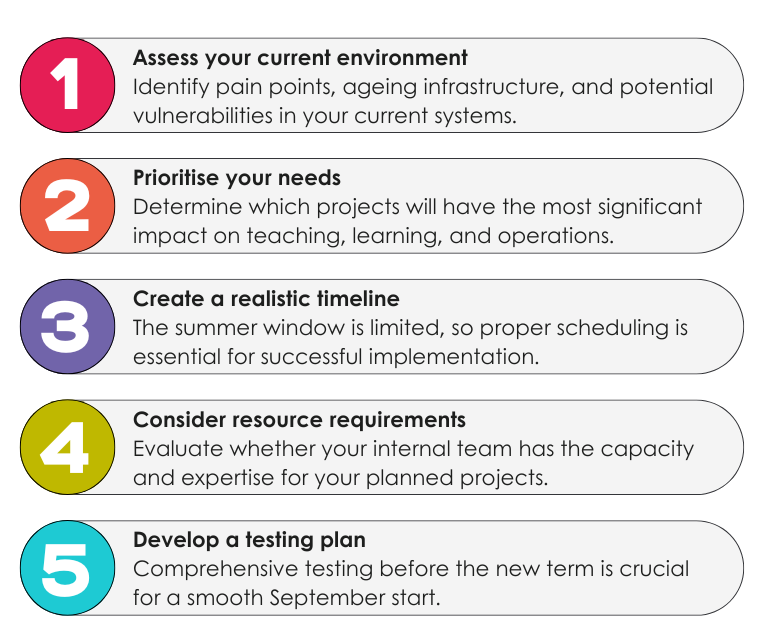The True Impact of Technology Failures
Most school leaders understand the direct costs of IT problems: emergency support callouts, replacement equipment, and repair fees. However, these visible expenses typically represent just the tip of the iceberg.
The more significant costs remain largely invisible:
Lost Teaching Time
When classroom technology fails, teachers must quickly pivot to alternative approaches. This transition isn’t just disruptive – it fundamentally changes the learning experience. Interactive lessons become static. Collaborative activities become individual. Digital resources become inaccessible.
Administrative Burden
School administration increasingly relies on digital systems for everything from attendance to parent communications. When these systems fail, administrative staff must resort to manual processes that are significantly more time-consuming.
Tasks that normally take minutes can expand to hours, creating backlogs that impact the entire school operation. Meanwhile, the core mission of supporting teaching and learning takes a backseat to crisis management.
Staff Frustration
Teachers enter the profession to educate and inspire young people – not to troubleshoot technology problems. Persistent IT issues create unnecessary stress and frustration, particularly during already demanding periods like exams or inspections.
As education faces ongoing challenges with recruitment and retention, technology reliability has become an increasingly important factor in staff satisfaction.
Parent Perception
Today’s parents expect seamless digital communication with their children’s schools. When technology failures disrupt these channels, it impacts more than just information flow – it shapes how parents perceive the school’s overall quality and organisation.
In our conversations with school leaders across the country, many have noted that technology reliability has become an increasingly significant factor in parent satisfaction and school choice.
–
The September Challenge
Perhaps no time highlights technology vulnerabilities more clearly than the start of the academic year. Our support data consistently shows that September accounts for a disproportionate share of school IT issues.
This “September effect” happens for several reasons:
- Systems that worked perfectly in July may develop problems during the summer inactivity
- Software updates and changes made over the holiday period face their first real test
- The sudden surge in network usage as staff and students return can reveal capacity issues
- New staff and students encounter unfamiliar systems, creating additional support needs
For many schools, these challenges create a difficult start to the new academic year precisely when first impressions matter most.
–
Why Summer Planning Is Critical
While not all technology problems can be prevented, our experience shows that proactive summer maintenance dramatically reduces disruption when schools return in September.
The six-week summer holiday provides a unique opportunity to address technology needs without disrupting teaching and learning. During this window, schools can:
- Conduct comprehensive infrastructure assessments
- Update critical systems and software
- Replace aging hardware before it fails
- Implement security improvements
- Prepare documentation and training materials for staff
- Recruit and embed the necessary support teams to ensure a smooth return
- Meet (or get closer to) the DfE Digital and Technology Standards
Most importantly, this work can be thoroughly tested before the pressure of term-time returns.
–
The Economics of Prevention
For school business managers and leaders focused on financial responsibility, preventative maintenance is not just an operational best practice – it’s an economic necessity.
Consider a typical secondary school that experiences just two days of significant IT disruption during a school year. When accounting for lost teaching time, administrative impact, and technical resolution costs, these disruptions can easily cost thousands of pounds – far more than proactive maintenance would require.
More importantly, these costs don’t account for the less tangible but equally important impacts: student learning loss, staff frustration, and parent dissatisfaction.
–
Starting Your Summer IT Planning
With June already here, forward-thinking schools are already planning their summer IT projects. If you haven’t started this process yet, there are several steps to consider:

A Partner for Your Summer IT Projects
At Dataspire, we’ve been helping schools implement successful summer IT projects for 20 years.
Our Summer IT Readiness programme provides a structured approach to planning, implementing, and testing technology changes during the critical summer window. From comprehensive network refreshes to focused improvemnts in specific areas, we tailor our approach to each school’s unique needs.
–
Looking Ahead
Technology continues to transform education, opening new possibilities for teaching and learning. Yet this increasing dependence also brings greater vulnerability to disruption.
As you plan for the coming academic year, we encourage you to consider the true cost of technology downtime in your school – and the opportunity that summer presents to create a more reliable, efficient, and effective IT environment.
Whether you implement changes with your internal team or seek external support with Dataspire, proactive summer planning is one of the most valuable investments you can make in your school’s technology infrastructure.
–
Do you want to learn more about planning your summer IT projects? Download Our Comprehensive Summer IT Reset Planner or book a free 20-minute consultation with one of our education technology specialists.
